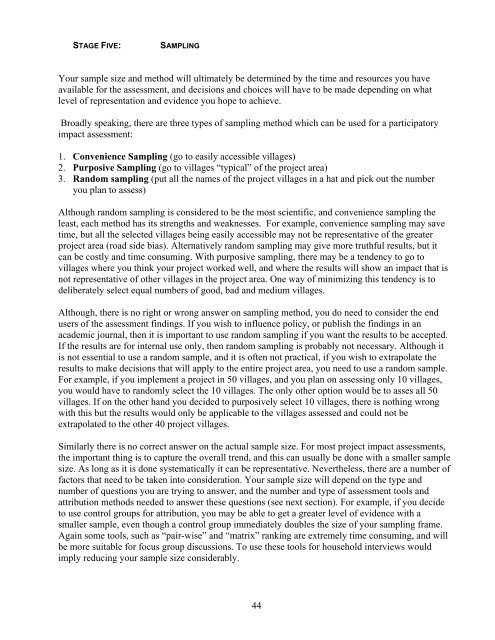Participatory Impact Assessment - Capacity4Dev
Participatory Impact Assessment - Capacity4Dev
Participatory Impact Assessment - Capacity4Dev
You also want an ePaper? Increase the reach of your titles
YUMPU automatically turns print PDFs into web optimized ePapers that Google loves.
STAGE FIVE:<br />
SAMPLING<br />
Your sample size and method will ultimately be determined by the time and resources you have<br />
available for the assessment, and decisions and choices will have to be made depending on what<br />
level of representation and evidence you hope to achieve.<br />
Broadly speaking, there are three types of sampling method which can be used for a participatory<br />
impact assessment:<br />
1. Convenience Sampling (go to easily accessible villages)<br />
2. Purposive Sampling (go to villages “typical” of the project area)<br />
3. Random sampling (put all the names of the project villages in a hat and pick out the number<br />
you plan to assess)<br />
Although random sampling is considered to be the most scientific, and convenience sampling the<br />
least, each method has its strengths and weaknesses. For example, convenience sampling may save<br />
time, but all the selected villages being easily accessible may not be representative of the greater<br />
project area (road side bias). Alternatively random sampling may give more truthful results, but it<br />
can be costly and time consuming. With purposive sampling, there may be a tendency to go to<br />
villages where you think your project worked well, and where the results will show an impact that is<br />
not representative of other villages in the project area. One way of minimizing this tendency is to<br />
deliberately select equal numbers of good, bad and medium villages.<br />
Although, there is no right or wrong answer on sampling method, you do need to consider the end<br />
users of the assessment findings. If you wish to influence policy, or publish the findings in an<br />
academic journal, then it is important to use random sampling if you want the results to be accepted.<br />
If the results are for internal use only, then random sampling is probably not necessary. Although it<br />
is not essential to use a random sample, and it is often not practical, if you wish to extrapolate the<br />
results to make decisions that will apply to the entire project area, you need to use a random sample.<br />
For example, if you implement a project in 50 villages, and you plan on assessing only 10 villages,<br />
you would have to randomly select the 10 villages. The only other option would be to asses all 50<br />
villages. If on the other hand you decided to purposively select 10 villages, there is nothing wrong<br />
with this but the results would only be applicable to the villages assessed and could not be<br />
extrapolated to the other 40 project villages.<br />
Similarly there is no correct answer on the actual sample size. For most project impact assessments,<br />
the important thing is to capture the overall trend, and this can usually be done with a smaller sample<br />
size. As long as it is done systematically it can be representative. Nevertheless, there are a number of<br />
factors that need to be taken into consideration. Your sample size will depend on the type and<br />
number of questions you are trying to answer, and the number and type of assessment tools and<br />
attribution methods needed to answer these questions (see next section). For example, if you decide<br />
to use control groups for attribution, you may be able to get a greater level of evidence with a<br />
smaller sample, even though a control group immediately doubles the size of your sampling frame.<br />
Again some tools, such as “pair-wise” and “matrix” ranking are extremely time consuming, and will<br />
be more suitable for focus group discussions. To use these tools for household interviews would<br />
imply reducing your sample size considerably.<br />
44

















